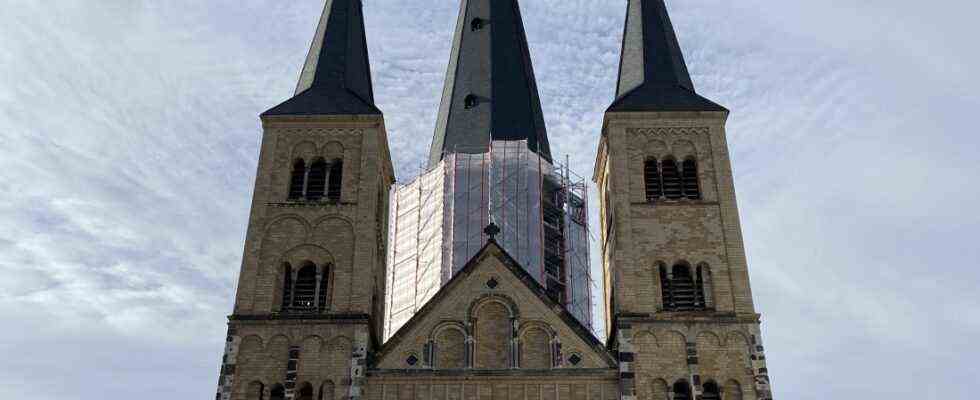On April 13, 1992 around 3:30 in the morning, people in the Rhineland were awakened by an earthquake. With a magnitude of 6.0 on the Richter scale, the largest earthquake ever measured north of the Alps, caused considerable damage between Heinsberg and Cologne. The walls of the Bonn Minster, however, the earliest surviving parts of which were almost 1000 years old, seemed miraculously to have survived the tremors almost unaffected.
Beethoven learned to play the organ in the Münster
Bonn Minster is somewhat overshadowed by its large Gothic neighbor, Cologne Cathedral. The building, which among other things served as a model for the Berlin Memorial Church, is of great architectural and general historical importance. The three-aisled basilica was one of the earliest large church complexes in the Rhineland, Bonn itself, long before it became the seat of government of the Bonn Republic, the seat of the Cologne archbishops. A highlight of its long history was the coronation of the Habsburg Frederick the Beautiful by Archbishop Heinrich von Virneburg as Roman-German King on November 25, 1314. Probably the most famous Bonn man, Ludwig van Beethoven, received organ lessons from the Münster organist Zensen as a ten-year-old, surpassing a classmate who was twice his age.
The fact that large cracks had formed under the modern silicate plaster of the Romanesque collegiate church, especially in the vault, during the earthquake of 1992 only became apparent when the electrical cables were being re-laid. “I don’t want to say that the congregation sat in the central nave at risk of death,” says city dean Wolfgang Picken. “But it was clear that restoring it while it was in operation would be far too risky.” In 2017, for example, the cathedral was initially closed for general refurbishment, temporarily profaned, and trade fairs and pastoral care for the community temporarily moved to the nearby Remigius Church.
Wolfgang Picken, who moved to the head of the city dean’s office from Bad Godesberg in 2019, proves to be a knowledgeable builder when inspecting the “Papal minor basilica of Saints Cassius, Florentius and Martin”. It describes the static challenges that resulted from the external inclination of the west apse with the organ gallery, and the securing of the long and transepts as well as the east apse using titanium anchors.
At Easter the church should be fully usable again. Until then, the exhibition “Light and Transparency” will be shown there with contemporary art such as Monica Bonvicini’s “rippings” (2021).
(Photo: Foundation for Art and Culture. VG Bild-Kunst. Bonn 2021. / Foundation for Art and Culture. VG Bild-Kunst, Bonn 2021.)
“The inside of this building was originally painted in color and whitewashed, but stone-visible, that means not plastered,” explains the dean. “The stone from the Siebengebirge and the Eifel is porous and its permeability ensures a regulated exchange of air.” Among other things, this exchange was interrupted by the plaster that was added during the Prussian redesign in the 19th century, as well as the mosaics in the choir apse. Part of the renovation was therefore an individual test of all sandstone and trachite elements. Where they could no longer be saved, they were replaced – around 80 percent of the external substance of the east apse was affected by this measure alone.
Anyone who remembers the impression of dark, cave-like appearance that the cathedral radiated before it was scaffolded, will be pleasantly surprised by the brightness of the newly designed interior. The low-hanging bronze candlesticks have disappeared, the triforium has been given indirect lighting, as has the crypt with the shrine of the city’s saints.
The oldest view of the city of Bonn was discovered under the dirt
The precious alabaster altars, which had darkened so much that they looked as if they had been modeled from plaster, after laser cleaning and the addition of missing putti heads, shine with the cleaned apse mosaic of Christ Pantocrator from the 19th century. The organ from the local manufacturer Klais is clean and has two stops added. The altar of the city saints, which used to stand somewhat unnoticed to the right of the main portal, is now the first thing you see when you enter the cathedral. When it was cleaned, the oldest view of Bonn to date came to light.
Dechant Picken, a clergyman with media experience, says that the basic renovation, which was largely carried out by the Archdiocese of Cologne and costing 22 million euros, and the resulting years of closure were necessary. But people have also got used to “walking past this place of worship with their shopping bags”. To get them back into the largest Catholic church in their city, Picken curated the exhibition “Light and Transparency” with works by contemporary artists such as Tony Cragg, Heinz Mack and Gerhard Richter. Cragg’s ubiquitous, amorphous sculptures in particular are in a strange tension with the newly renovated sacred space. But the audience on the day of the visit is great, the Bonners seem to be equally interested in the results of the renovation and the art exhibition.
The renovation of the exterior will take until 2023. However, the cathedral is to be completely restored to its intended use as a place of worship by Easter next year. And now one can understand again why Ludwig van Beethoven said in a conversation with his Bonn friend Franz Gerhard Wegeler that he would give up “all of Vienna” for “the Münsterplatz with the beautiful old minster”.

